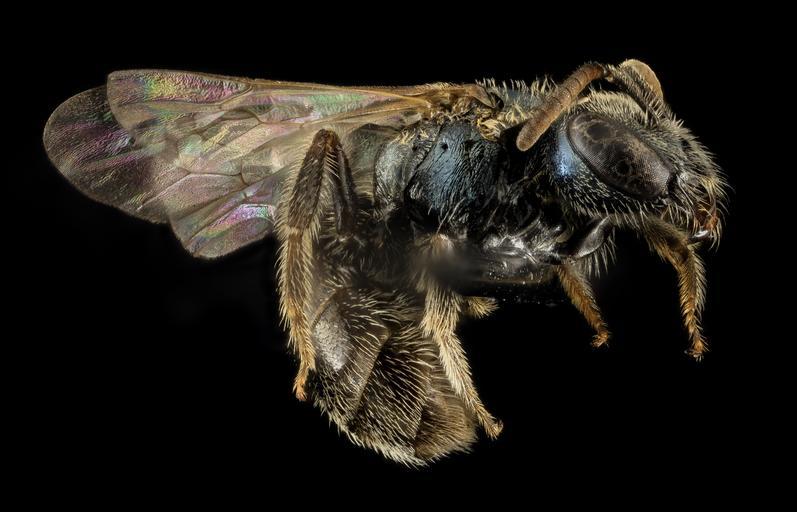MAKE A MEME
View Large Image

| View Original: | Lasioglossum_michiganense,_F,_Side,_NY,_Queens_2014-04-22-14.59.53_ZS_PMax.jpg (5200x3342) | |||
| Download: | Original | Medium | Small | Thumb |
| Courtesy of: | www.flickr.com | More Like This | ||
| Keywords: bee bees lasioglossum michiganense lasioglossummichiganense taxonomy: binomial = lasioglossum michiganense taxonomybinomiallasioglossummichiganense lasioglossum halictidae queens new york city newyorkcity cleptoparasite rare breezy point breezypoint parasite nest parasites nestparasites hymenoptera droege usgs usgsbiml national park service national park service nationalparkservice nps gateway national recreation area gatewaynationalrecreationarea gate animal black background photo border Now, this is an interesting bee. Obviously it has occurred in Michigan, and indeed until quite recently that was the only place it was known from and in fact, was known only from one single specimen. However, it was so unique that was described by Ted Mitchell over 50 years ago as a new species. Part of its uniqueness is that it is a cleptoparasite of other Lasioglossum species. Also interesting is the fact that it was found, this particular specimen that is, in Queens, New York City at the very tip of breezy point. You never know what interesting natural history you'll find anywhere. Photographed by Brooke Alexander. ~~~~~~~~~~{{{{{{0}}}}}}~~~~~~~~~~ All photographs are public domain, feel free to download and use as you wish. Photography Information: Canon Mark II 5D, Zerene Stacker, Stackshot Sled, 65mm Canon MP-E 1-5X macro lens, Twin Macro Flash in Styrofoam Cooler, F5.0, ISO 100, Shutter Speed 200 Beauty is truth, truth beauty - that is all Ye know on earth and all ye need to know " Ode on a Grecian Urn" John Keats You can also follow us on Instagram account USGSBIML Want some Useful Links to the Techniques We Use? Well now here you go Citizen: Art Photo Book: Bees: An Up-Close Look at Pollinators Around the World www.qbookshop.com/products/216627/9780760347386/Bees.html... Basic USGSBIML set up: www.youtube.com/watch?v=S-_yvIsucOY USGSBIML Photoshopping Technique: Note that we now have added using the burn tool at 50% opacity set to shadows to clean up the halos that bleed into the black background from "hot" color sections of the picture. www.youtube.com/watch?v=Bdmx_8zqvN4 PDF of Basic USGSBIML Photography Set Up: ftp://ftpext.usgs.gov/pub/er/md/laurel/Droege/How%20to%20Take%20MacroPhotographs%20of%20Insects%20BIML%20Lab2.pdf Google Hangout Demonstration of Techniques: plus.google.com/events/c5569losvskrv2nu606ltof8odo or www.youtube.com/watch?v=4c15neFttoU Excellent Technical Form on Stacking: www.photomacrography.net/ Contact information: Sam Droege sdroege@usgs.gov 301 497 5840 Now, this is an interesting bee. Obviously it has occurred in Michigan, and indeed until quite recently that was the only place it was known from and in fact, was known only from one single specimen. However, it was so unique that was described by Ted Mitchell over 50 years ago as a new species. Part of its uniqueness is that it is a cleptoparasite of other Lasioglossum species. Also interesting is the fact that it was found, this particular specimen that is, in Queens, New York City at the very tip of breezy point. You never know what interesting natural history you'll find anywhere. Photographed by Brooke Alexander. ~~~~~~~~~~{{{{{{0}}}}}}~~~~~~~~~~ All photographs are public domain, feel free to download and use as you wish. Photography Information: Canon Mark II 5D, Zerene Stacker, Stackshot Sled, 65mm Canon MP-E 1-5X macro lens, Twin Macro Flash in Styrofoam Cooler, F5.0, ISO 100, Shutter Speed 200 Beauty is truth, truth beauty - that is all Ye know on earth and all ye need to know " Ode on a Grecian Urn" John Keats You can also follow us on Instagram account USGSBIML Want some Useful Links to the Techniques We Use? Well now here you go Citizen: Art Photo Book: Bees: An Up-Close Look at Pollinators Around the World www.qbookshop.com/products/216627/9780760347386/Bees.html... Basic USGSBIML set up: www.youtube.com/watch?v=S-_yvIsucOY USGSBIML Photoshopping Technique: Note that we now have added using the burn tool at 50% opacity set to shadows to clean up the halos that bleed into the black background from "hot" color sections of the picture. www.youtube.com/watch?v=Bdmx_8zqvN4 PDF of Basic USGSBIML Photography Set Up: ftp://ftpext.usgs.gov/pub/er/md/laurel/Droege/How%20to%20Take%20MacroPhotographs%20of%20Insects%20BIML%20Lab2.pdf Google Hangout Demonstration of Techniques: plus.google.com/events/c5569losvskrv2nu606ltof8odo or www.youtube.com/watch?v=4c15neFttoU Excellent Technical Form on Stacking: www.photomacrography.net/ Contact information: Sam Droege sdroege@usgs.gov 301 497 5840 | ||||